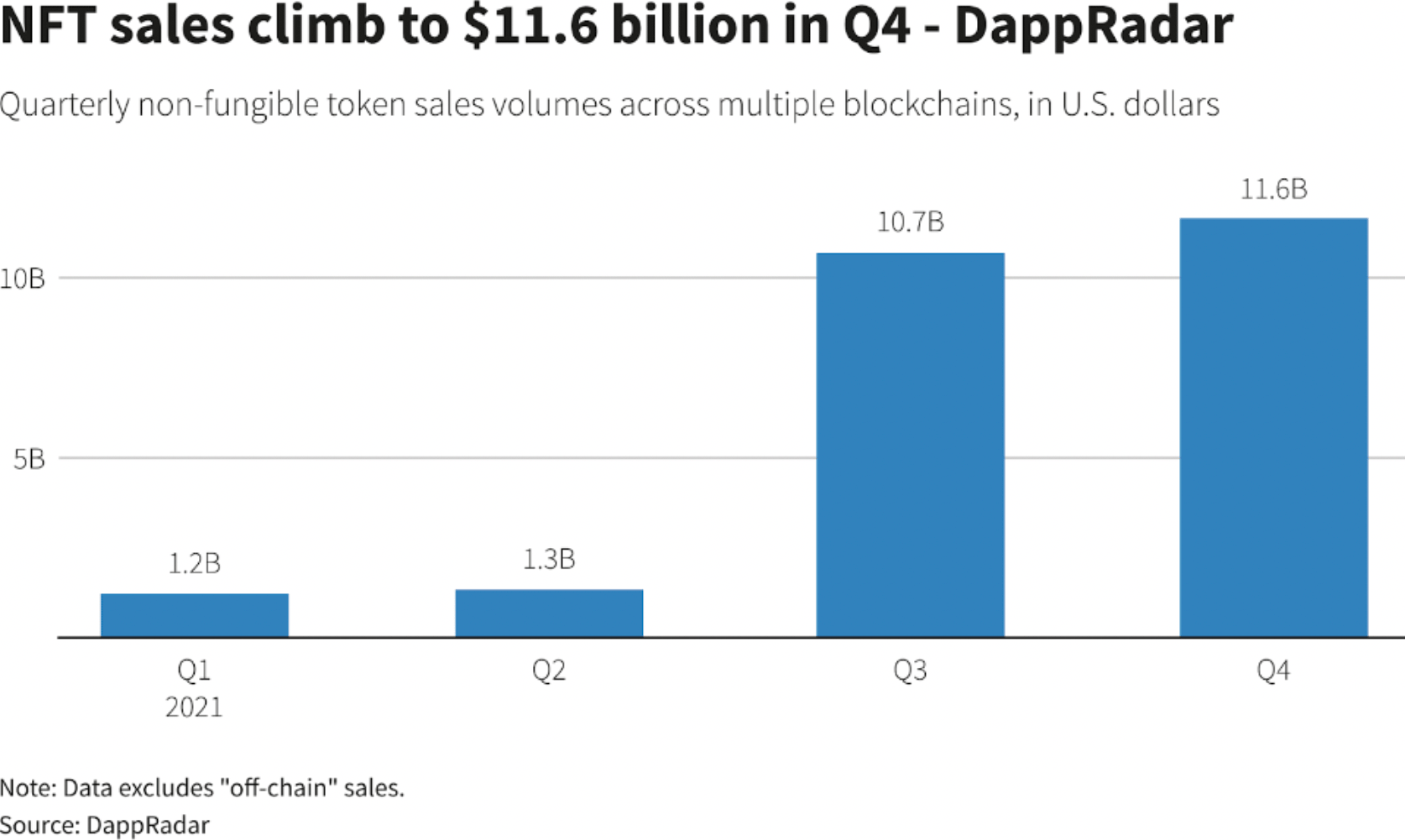


|
||
|
||
NFTs continue to explode in popularity, reaching $25 billion in sales in 2021 as reported by Reuters. NFTs, or non-fungible tokens, are cryptoassets in which each token is unique. At its most basic, NFTs are used to transform digital content into one-of-a-kind, verifiable assets. This uniqueness means that unlike other forms of cryptoassets like Bitcoin, NFTs are not mutually interchangeable and no two are the same.
These individual assets are then traded and stored on the blockchain. While these assets can be freely viewed, copied, and distributed like any other online file, true ownership resides with the original purchaser and is recorded within the blockchain. These speculative cryptoassets are used to represent digital items like images, videos, GIFs, tweets, video game skins and assets, and even virtual property in virtual worlds. One investor even claims that stocks and real estate will become NFTs in the future.
In 2021, NFT sales reached an estimated $24.9 billion. That’s up from $94.9 million the year before.

Brands have been quick to get in on the NFT action. Quick serve food companies like Taco Bell, and Pizza Hut, have issued their own NFTs. Snack food giant Pringles and even Dunkaroos have issued NFTs. So have Nike, and even luxury brands like Gucci. In 2021 auction house Sotheby’s sold $65 million of NFTs and Christie’s sold more than $100 million.
While the excitement around NFTs continues to grow, there are some very real-world concerns. As with any online trend with a lot of interest and a lot of money, bad actors are quick to try to cash in as well. As we’ve reported before, cybercriminals are constantly innovating their techniques when it comes to perpetrating their scams, and NFTs are no exception. Even if your brand isn’t currently experimenting with or generating NFTs, remaining vigilant as to where and how your intellectual property is being used is critical to keeping your consumers’ experiences with your brand authentic and protecting your brand.
Here are some specific things to watch for when it comes to monitoring NFTs and the potential unauthorized use of your intellectual property.
Brands need to keep an even sharper eye on social media accounts than ever before. While social media has always been an area for strict brand protection monitoring and should be a key component of any robust brand protection strategy, bad actors looking to capitalize on the NFT boom are using social media as a fast and easy way to reach potential victims. Cybercriminals are creating fake accounts in order to sell fake NFT artwork, often using logos and content from legitimate brands to disguise themselves and provide an aura of ‘authenticity’.
In addition to selling fake NFTs, these accounts often hold giveaways, using the lure of an NFT prize. ‘Winners’ of these scams are given a link to another website that is used to collect personal information and, in many cases, harvest the victim’s crypto wallets and seed phrases, or passwords.
Another NFT scam is the investor scam. In situations like this, bad actors promote an upcoming project, new business, or the launch of a new and exciting product using digital marketing tactics and channels to solicit investors. These scams can masquerade as legitimate brands and businesses, again using well-known and trusted logos and images. Unfortunately, these scams are often rug-pulls, with the perpetrators collecting cryptocurrency from their investors and then disappearing, taking the profits without delivering anything.
As NFTs continue to grow in popularity, questions about how to protect both intellectual property and consumers will increase as well. If you want to learn more about how you can help keep your brand resilient online in the face of this emerging technology, please contact us, and we’ll be glad to help.
Sponsored byDNIB.com

Sponsored byVerisign

Sponsored byIPv4.Global

Sponsored byWhoisXML API

Sponsored byCSC

Sponsored byVerisign

Sponsored byRadix
